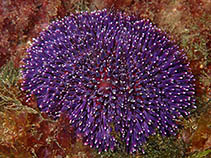Sphaerechinus granularis (Lamarck, 1816)
| Native range | All suitable habitat | Point map | Year 2050 |

|
| This map was computer-generated and has not yet been reviewed. |
| Sphaerechinus granularis AquaMaps Data sources: GBIF OBIS |
Classification / Names Common names | Synonyms | CoL | ITIS | WoRMS
Echinoidea | Camarodonta | Toxopneustidae
Environment: milieu / climate zone / depth range / distribution range Ecology
Benthic; depth range 2 - 130 m (Ref. 85345). Temperate; 53°N - 13°N, 32°W - 37°E
Distribution Countries | FAO areas | Ecosystems | Occurrences | Introductions
Eastern Atlantic and the Mediterranean Sea: from Ireland to the English Channel (French coast) to Spain, into the entire Mediterranean, to Morocco and Gulf of Guinea, including the islands of Azores, Madeira, Canary and Cape Verde. Temperate and subtropical.
Length at first maturity / Size / Weight / Age
Maturity: Lm ? range ? - ? cm
Life cycle and mating behavior Maturity | Reproduction | Spawning | Eggs | Fecundity | Larvae
Main reference
References | Coordinator | Collaborators
Gaspar, M.B., M.D. Dias, A. Campos, C.C. Monteiro, M.N. Santos, A. Chicharo and L. Chicharo 2001 The Influence of dredge design on the catch of Callista chione (Linaeus, 1758). Hydrobiologia 465:153-167. (Ref. 2714)
IUCN Red List Status
(Ref. 130435: Version 2025-1)
CITES status (Ref. 108899)
CMS (Ref. 116361)
Threat to humans
Human uses
| FishSource |
Tools
More information
Max. ages / sizes
Length-weight rel.
Length-length rel.
Length-frequencies
Mass conversion
Abundance
Internet sources
BHL | BOLD Systems | CISTI | DiscoverLife | FAO(Publication : search) | Fishipedia | GenBank (genome, nucleotide) | GloBI | Gomexsi | Google Books | Google Scholar | Google | PubMed | Tree of Life | Wikipedia (Go, Search) | Zoological Record



